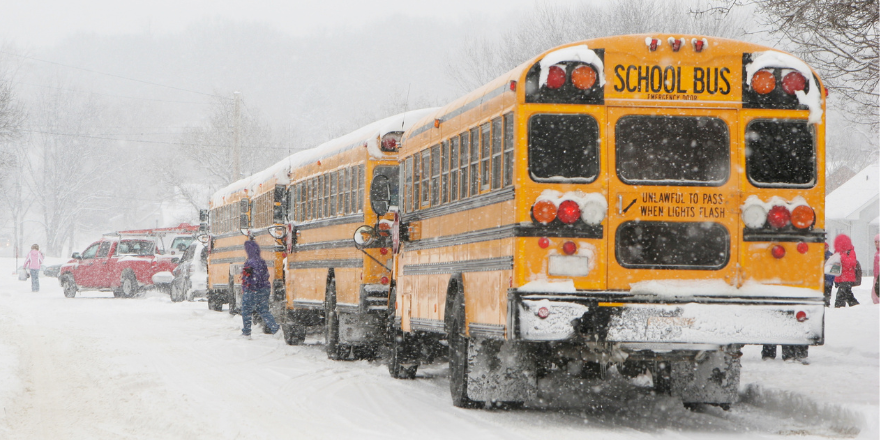For school bus operators in particular, winter driving requires extra vigilance and a carefully developed set of skills and strategies. From ice patches to reduced visibility, the challenges of winter weather mean everyone on the road needs to be at the top of their games to ensure safer travel.
In keeping with our mission to create and maintain reliable, efficient, and safe transportation programs that provide universal access to education, we’ve put together the following tips to help keep school districts, bus drivers, students, and the entire community safer this winter.
Plan with the entire team
Planning well in advance is the first step to ensuring safe, efficient student transportation in winter. While each school bus contractor will have its own agreed-upon procedures with the school districts and communities served, here are some points to consider for any severe weather plan:
- Communications. Establish clear communications protocols that consider all parties involved: drivers, district leadership, staff, and student families. Make sure your plan includes the methods of communication (email, phone, or social media, for example), as well as who will make decisions and share information, and when.
- Routing. Alternate or shortened routes can be planned and shared ahead of time, so drivers can be familiar with any possible changes before weather hits.
- Adjusted schedules. Whether for a delayed or earlier start time or full cancellation of a school day, schedule adjustments – along with the decision-making process behind them – should be established between a school bus contractor and district leadership long before the first snowflake falls.
- On-the-road procedures. In case a vehicle becomes disabled or road conditions deteriorate, school administrators should make sure their school bus contractor has specific, detailed emergency procedures in place, designed to keep students and drivers safe.
- Safety training. At our partner contractor, Krise Transportation, the challenges of winter driving and other timely topics are addressed through extensive training, including regular safety meetings.
Ensure vehicle readiness and maintenance
Make sure your vehicle technicians adhere to rigorous fleet maintenance programs, to ensure every vehicle can operate safely when you’re on the road.
Some key winter preparations for buses include:
- Regular maintenance. While all student transportation providers must keep current on mandated inspections and maintenance, there are also preventive and corrective practices that help ensure safer winter operations, including checking fluids more frequently, testing batteries, checking for sufficient tread on tires, or adding anti-fog products to windshield and mirror interiors.
- Winter pre-trip procedures. Drivers should conduct a thorough pre-trip inspection before every run, as required by law. For safer winter operations, drivers should also:
- Clear windows, mirrors, lights, and stop arms of snow and ice
- Ensure automatic tire chains (if equipped) are ready if needed
- Remain cautious of bridges and overpasses during winter, when packed snow might reduce overhead clearance
Winter driving tips for the community
Most importantly, if you’re a school administrator, parent, or any other community member, decide whether you really need to drive during inclement weather. If you’re unsure, tend toward caution and stay off the road whenever possible.
If you do need to drive, these suggestions may help you avoid some of the most common risks of winter driving:
- Monitor weather conditions. Pay attention to the forecast and the current weather so you know what to expect on the road. Be aware of any warnings or advisories issued by the National Weather Service.
- Check visibility. Clear all snow and ice off of your vehicle before driving, including all windows, side mirrors, lights, and the roof. Take a few minutes to defrost your windows before hitting the road. Turn on your headlights for better visibility, even during the daytime. And always use your turn signals to ensure that other motorists and pedestrians can see you and know where you are heading.
- Go slow. Allow yourself extra time to get to your destination, and drive slowly. And hold off on cruise control since you’ll need to be alert and ready for any sudden changes on the road.
- Leave space. Keep a safe distance from the vehicle in front of you. Remember, wintry conditions dramatically increase stopping times and distances.
- Look around. We urge every motorist to watch for students, pedestrians, and school buses year-round – and winter driving calls for extra vigilance.
- Check your technique. Avoid sudden movements or braking, as this can cause your vehicle to slide. An abundance of caution helps keep everyone safer in winter weather.
Safety tips for students and pedestrians
Here are a few suggestions for student and anyone walking in school zones or near roadways:
- Stay informed. Wake up early and find out whether school is delayed or canceled for a snow day.
- Get prepared. Transportation schedules may be delayed, so proper clothing designed for cold can minimize weather exposure dangers. Proper footwear for icy or snowy conditions is also essential.
- Leave extra time. Just as cars and buses should slow down in bad weather, so should you. Leave extra time to get ready and reach your bus stop, so you don’t have to rush. A slower pace can help prevent slips and falls.
- Stay alert. Always pay close attention near crosswalks, parking lots, roadways, or any area with traffic. Follow all safety precautions, walk with hands free and out of pockets for improved balance, and never walk while you’re distracted by your phone, friends, or anything else!
- Use handrails. When you’re getting on or off any bus, use the handrails for better stability. This is true in any weather, but especially when there’s a greater chance of water or snow being tracked onboard by other riders.
Contact us
If you’re a school bus contractor seeking growth, reach out to us. We’d love to hear from you.
American Student Transportation Partners (ASTP) is a dynamic network of safe, dependable student transportation providers. We’re driving the future of student transportation by providing access to education through reliable, efficient student transportation programs. Exceptional bus operators choose ASTP because of our innovative approach to partnership, as well as the resources we provide to help “future-proof” their operations.
To learn more about partnering with ASTP, contact Tod Eskra, President, at [email protected] or call (314) 560-5946.

